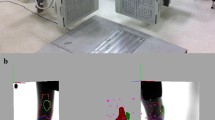Abstract
Background
The lower limb osteometry of Chinese differs from that of whites. The joint line of the knee in the coronal plane in Chinese is more medially inclined and the posterior condylar angle of the distal femur in the axial plane is larger. However, it is unclear whether there is any direct association between the coronal plane and axial plane osteometry.
Questions/purposes
We asked whether the joint line obliquity of the knee is related to the posterior condylar angle of the distal femur in young Chinese subjects.
Methods
Ninety-nine young Chinese patients with anterior cruciate ligament injuries were recruited. The lower limb alignment and joint line obliquity were measured using standing long radiographs of the whole lower limb. The rotational alignment of the distal femur was assessed in the axial cuts of the MRI.
Results
The distal femur rotational alignment was associated with the obliquity of the knee in Chinese. The posterior condylar angle was 5° ± 2°. The knee was 5° ± 3° medially inclined.
Conclusions
The joint line of the knee in a group of young Chinese patients was more medially inclined than that of whites. The posterior condylar angle of the distal femur was larger. The presence of an association between distal femur rotational alignment and joint line obliquity in this group of young Chinese patients suggests a possible developmental cause explaining the difference in osteometry between races.







Similar content being viewed by others
References
Akagi M, Matsusue Y, Mata T, Asada Y, Horiguchi M, Iida H, Nakamura T. Effect of rotational alignment on patellar tracking in total knee arthroplasty. Clin Orthop Relat Res. 1999;366:155–163.
Berger RA, Crossett LS, Jacobs JJ, Rubash HE. Malrotation causing patellofemoral complications after total knee arthroplasty. Clin Orthop Relat Res. 1998;356:144–153.
Berger RA, Rubash HE, Seel MJ, Thompson WH, Crossett LS. Determining the rotational alignment of the femoral component in total knee arthroplasty using the epicondylar axis. Clin Orthop Relat Res. 1993;286:40–47.
Chiu KY, Zhang SD, Zhang GH. Posterior slope of tibial plateau in Chinese. J Arthroplasty. 2000;15:224–227.
Griffin FM, Math K, Scuderi GR, Insall JN, Poilvache PL. Anatomy of the epicondyles of the distal femur. MRI analysis of normal knees. J Arthroplasty. 2000;15:354–359.
Hood RW, Vanni M, Insall JN. The correction of knee alignment in 225 consecutive total condylar knee replacements. Clin Orthop Relat Res. 1981;160:94–105.
Hsu RWW, Himeno S, Coventry MB, Chao EYS. Normal axial alignment of the lower limb and load-bearing distribution at the knee. Clin Orthop Relat Res. 1990;255:215–227.
Insall JN, Binazzi R, Soudry M, Mestriner LA. Total knee arthroplasty. Clin Orthop Relat Res. 1985;192:13–22.
Jiang CC, Insall JN. Effect of rotation on the axial alignment of the femur. Pitfalls in the use of femoral intramedullary guides in total knee arthroplasty. Clin Orthop Relat Res. 1989;248:50–56.
Kellegren JH, Lawrence JS. Radiological assessment of osteoarthritis. Ann Rheum Dis. 1957;16:494–501.
Ko PS, Tio MK, Ban CM, Mak YK, Ip FK, Lam JJ. Radiologic analysis of the tibial intramedullary canal in Chinese varus knees: implications in total knee arthroplasty. J Arthroplasty. 2001;16:212–215.
Lie CWH, Yau WP, Chiu KY, Leung HB, Wong LLS, Wong SHM. Interobserver and intraobserver error in distal femur transepicondylar axis measurement with computed tomography. J Arthroplasty. 2009;24:96–100.
Lohmander LS, Ostenberg A, Englund M, Roos H. High prevalence of knee osteoarthritis, pain, and functional limitations in female soccer players twelve years after anterior cruciate ligament injury. Arthritis Rheum. 2004;50:3145–3152.
Moreland JR, Bassett LW, Hanker GJ. Radiographic analysis of the axial alignment of the lower extremity. J Bone Joint Surg Am. 1987;69:745–749.
Neuman P, Englund M, Kostogiannis I, Friden T, Roos H, Dahlberg LE. Prevalence of tibiofemoral osteoarthritis 15 years after nonoperative treatment of anterior cruciate ligament injury: a prospective cohort study. Am J Sports Med. 2008;36:1717–1725.
Neuman P, Kostogiannis I, Friden T, Roos H, Dahlberg LE, Englund M. Patellofemoral osteoarthritis 15 years after anterior cruciate ligament injury—a prospective cohort study. Osteoarthritis Cartilage. 2009;17:284–290.
Oiestad BE, Engebretsen L, Storheim K, Risberg MA. Knee osteoarthritis after anterior cruciate ligament injury: a systematic review. Am J Sports Med. 2009;37:1434–1443.
Ritter MA, Faris PM, Keating EM, Meding JB. Postoperative alignment of total knee replacement. Its effect on survival. Clin Orthop Relat Res. 1994;299:153–156.
Tang WM, Chiu KY, Kwan MF, Ng TP, Yau WP. Sagittal bowing of the distal femur in Chinese patients who require total knee arthroplasty. J Orthop Res. 2005;23:41–45.
Tang WM, Zhu YH, Chiu KY. Axial alignment of the lower extremity in Chinese patients. J Bone Joint Surg Am. 2000;82:1603–1608.
Yau WP, Chiu KY, Tang WM. Computer Navigation did not improve alignment in a lower-volume total knee practice. Clin Orthop Relat Res. 2008;466:935–945.
Yau WP, Chiu KY, Tang WM, Ng TP. Coronal bowing of the femur and tibia in Chinese: its incidence and effects on total knee arthroplasty planning. J Orthop Surg (Hong Kong). 2007;15:32–36.
Yip DK, Zhu YH, Chiu KY, Ng TP. Distal rotational alignment of the Chinese femur and its relevance in total knee arthroplasty. J Arthroplasty. 2004;19:613–619.
Author information
Authors and Affiliations
Corresponding author
Additional information
Each author certifies that he or she, or a member of his or her immediate family, has no funding or commercial associations (eg, consultancies, stock ownership, equity interest, patent/licensing arrangements, etc) that might pose a conflict of interest in connection with the submitted article.
All ICMJE Conflict of Interest Forms for authors and Clinical Orthopaedics and Related Research editors and board members are on file with the publication and can be viewed on request.
Each author certifies that his or her institution approved or waived approval for the reporting of this case and that all investigations were conducted in conformity with ethical principles of research.
About this article
Cite this article
Yau, W.P., Chiu, K.Y., Fok, A.W.M. et al. Distal Femur Rotation Relates to Joint Obliquity in ACL-deficient Chinese. Clin Orthop Relat Res 471, 1458–1464 (2013). https://doi.org/10.1007/s11999-012-2698-4
Published:
Issue Date:
DOI: https://doi.org/10.1007/s11999-012-2698-4




